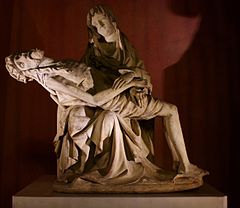St. Barbara Church (Krakow)
| Barbarakirche | |
|---|---|
|
View from the pl. Mariacki |
|
| Construction year: | 1263 |
| Inauguration: | 1295 |
| Style elements : | Gothic , baroque |
| Client: | Catholic Church |
| Location: | 50 ° 3 '40.8 " N , 19 ° 56' 23.5" E |
| Address: | pl. Mariacki Krakow Poland |
| Purpose: | Roman Catholic Jesuit Church |
| Diocese : | Krakow |

The Barbara Church (Pol. Kościół św. Barbary ) in Krakow , Poland , is a Roman Catholic church, is due to its history, its architecture and its art treasures to the most characteristic buildings of Krakow's Old Town. In close historical connection with the imposing St. Mary's Church and the Jesuit order in Poland, it reflects the history of the Wawel city over the course of six centuries. A few times the owners of the building changed and with it the purpose and the character. Redesigned several times and enriched with approaches from different epochs, the Gothic and Baroque in particular combine to form a picturesque whole.
The Marienplatz between the churches of St. Barbara and St. Marien is considered by artists to be one of the most beautiful in old Krakow. The Barbarakirche can be seen in whole or in part on numerous paintings by well-known artists.
history
The beginnings of the Barbarakirche are lost in the darkness of history. According to an old Krakow legend, the St. Barbara's Church was built at the same time as St. Mary's Church. According to this, the members of the masons' guild employed in the construction of the Kraków St. Mary's Church are said to have built the St. Barbara Church from leftover building material as a votive offering.
It is more likely that the cemetery chapel built by the Krakow citizen Nikolaus Wierzynek on the Marienkirchhof, today's Marienplatz, represents the origin of today's church.
In the years 1394–1402 the three-bay chapel (probably from the funds of the Queen Hedwig Foundation) was extended by two more bays to form the church. At that time the church already had four side altars in addition to the main altar.
Due to the growing German community, the sermons in Polish were displaced from the Marienkirche to the Barbarakirche. In addition to the Polish sermons , the religious services of the brotherhoods operating here were held in the smaller church .
At the winter session ANNO 1536/37 of the Polish Parliament ( Sejm ) in Krakow, King Sigismund I ordered the sermons in Polish to be relocated to the large St. Mary's Church. The German sermons, on the other hand, were to be held in the Barbarakirche. On the one hand, this was a testimony to the awakening of national self-confidence and the development of national pride, on the other hand, it was also the result of the polonization of the German bourgeoisie.
After a break of more than 50 years since 1945, due to the anti-German attitude of the communist government, Holy Mass has been read in German again on Sundays and public holidays since 1997 in St. Barbara's Church .
local community
The church is used today by both Polish Catholics and German-speaking believers.
The German-speaking congregation has developed ecumenical approaches since the beginning, as many parishioners are ecumenically married. In addition to monthly community meetings, the main focus is always on concerts by European choirs, musicians and soloists. The St. Barbara Choir of the two parishes contributes in particular to this.
Furnishing
The Barbarakirche has been restored at great expense since 2002. In 2002 the facade was cleaned and in 2003 restoration work began on the interior.
The most important work of art in the church is the sculpture of Our Lady of Sorrows Pietà by the master of beautiful Madonnas from Wroclaw .
organ
The organ was built in 1894 by the Rieger organ building company. The cone store instrument has 16 stops on two manuals and a pedal. The playing and stop actions are mechanical.
|
|
|
|||||||||||||||||||||||||||||||||||||||||||||||||||||||||||||||||||||||||||||||||||||||||||||||||
- Coupling : II / I, I / P,
- Playing aids : Fixed combinations (Forte I, Forte II, Tutti), register crescendo


